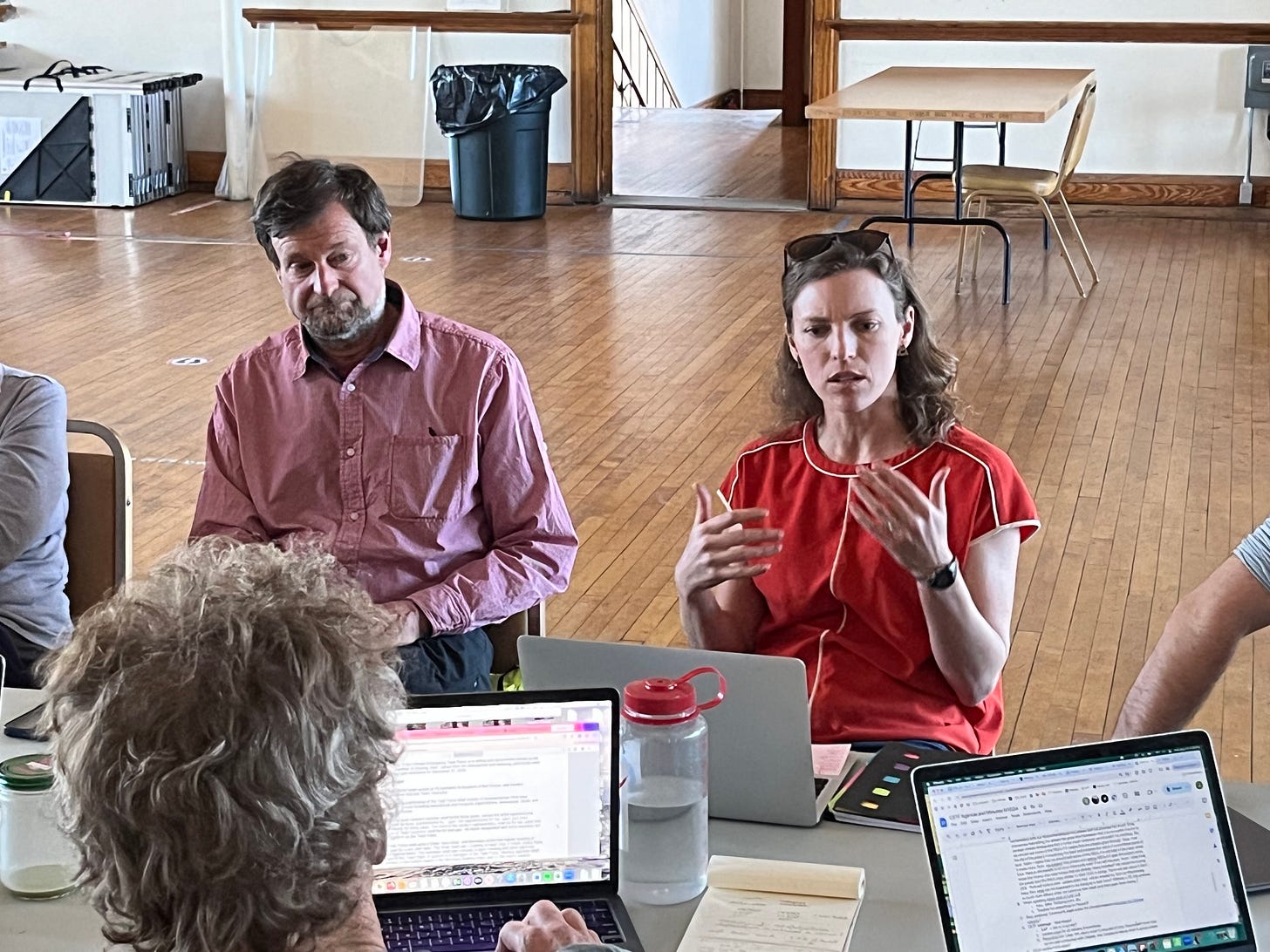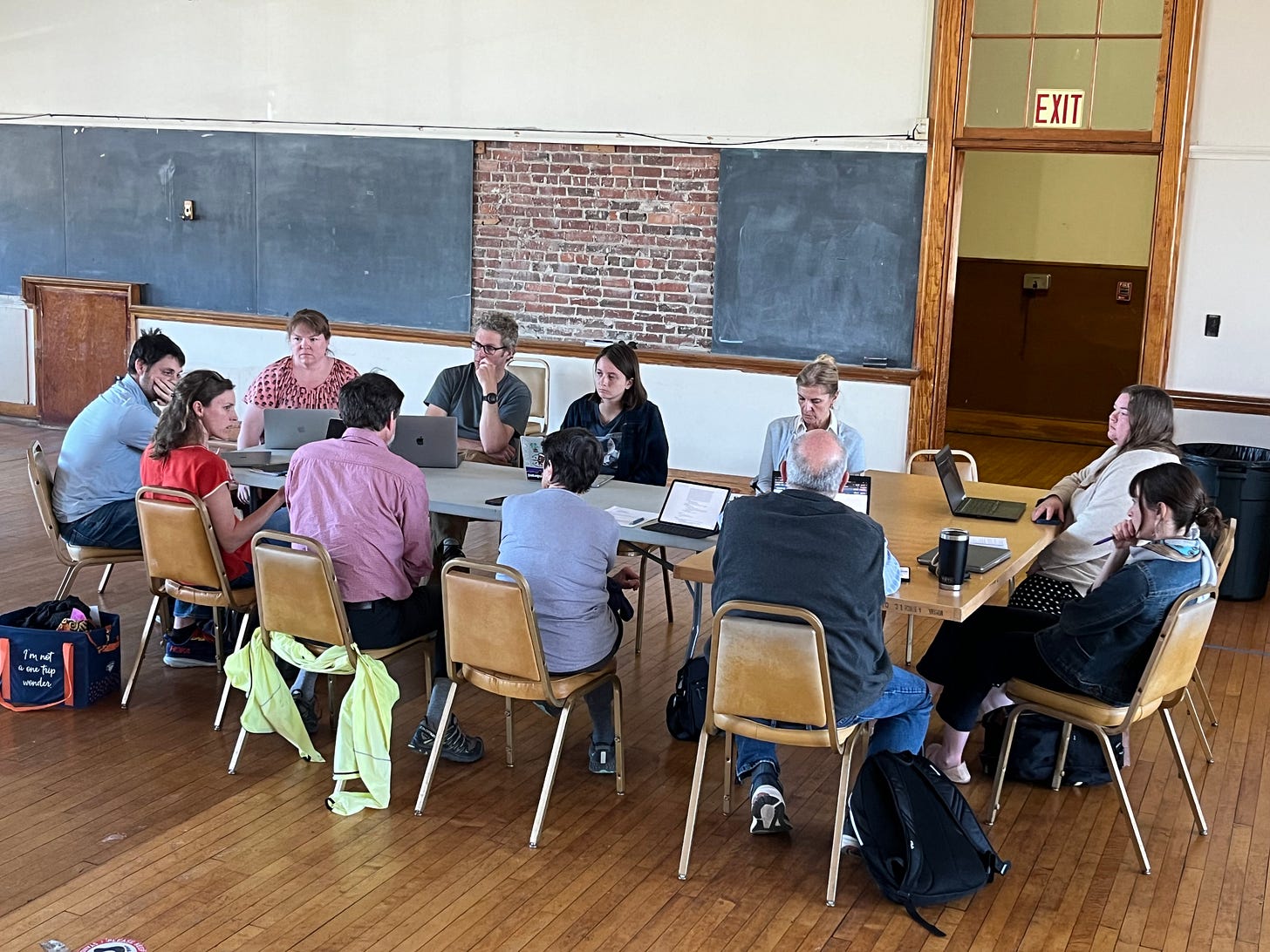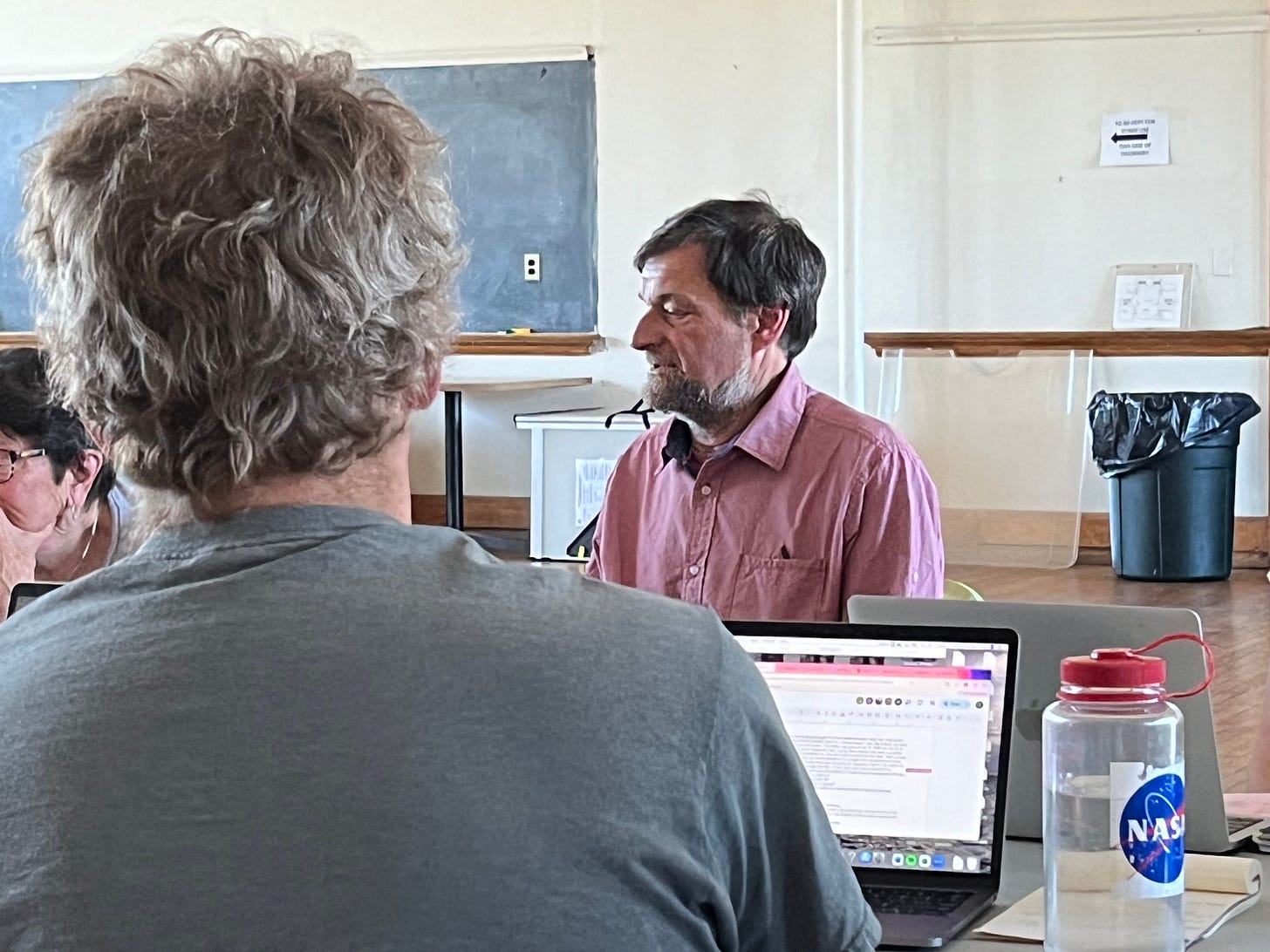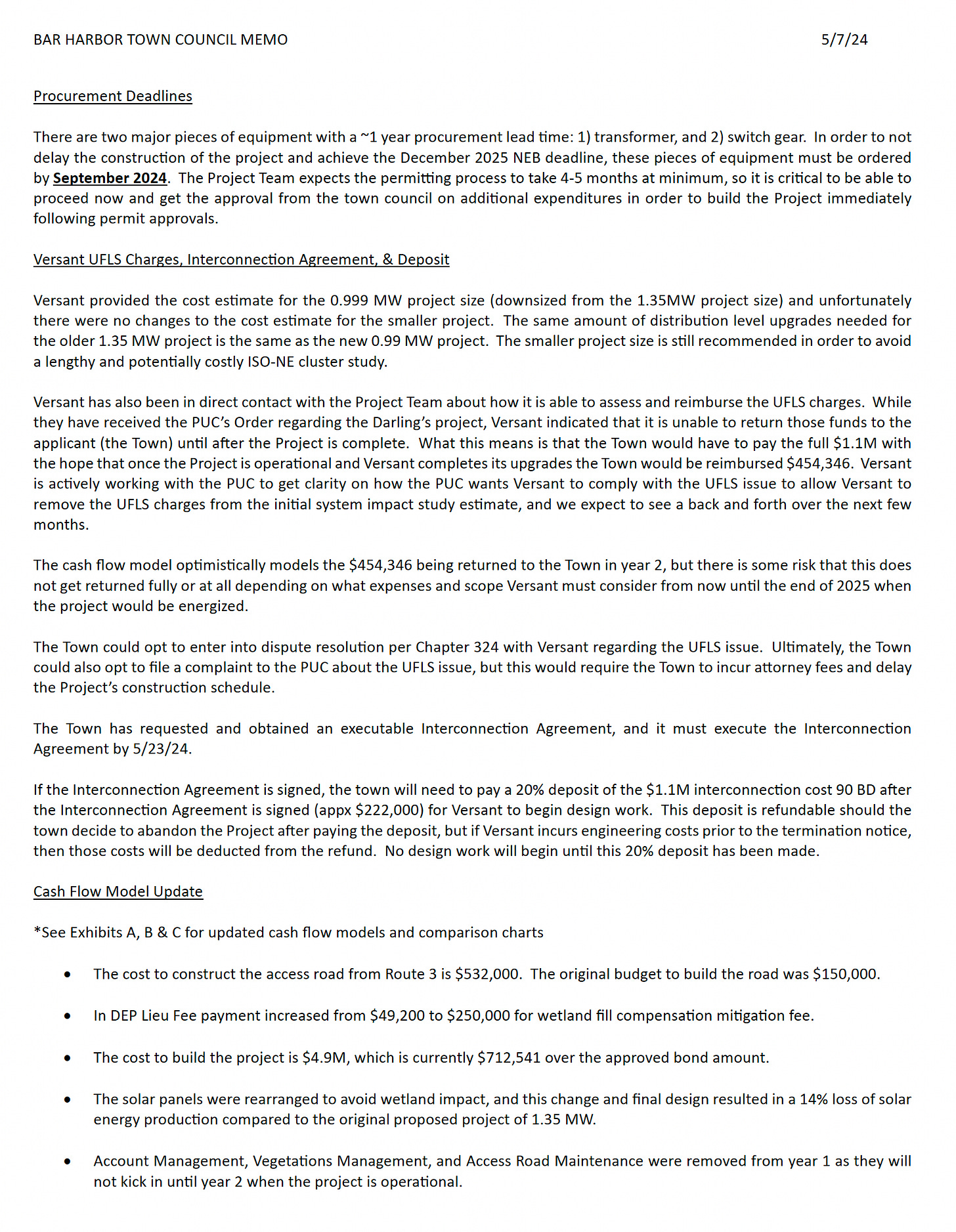Future Still Uncertain: Higgins Pit Solar Array
Bar Harbor's project's tight timeline and increasing costs puts it at risk
BAR HARBOR—After more than 90 minutes of discussion, the Town Council postponed action on the Higgins Pit Solar Project again this past week. Instead, it asked for another round of information.
A resolve about the project was tabled from the Council’s April 16 meeting so that the town’s consultant and contractor could present an update. That update came May 7 and the resolve was not moved forward. They did not vote to table the resolve. They took no action.
“I think there’s a strong need in the community for us to do something meaningful and impactful for our climate goals,” Town Manager James Smith told councilors at their May 7 meeting. “We want to do something meaningful and impactful. The question is if the council can do that with this project and its time constraints.”
Concerns about costs and timelines put a damper on the project’s forward motion. Those concerns were detailed in a May 7 memo to the council from the Higgins Pit Solar Project team, Smith, Public Works Director Bethany Leavitt, Finance Director Sarah Gilbert, and Chris Byers, the consultant to the town.
BACKGROUND
The project would create a 0.99 megawatts facility, downsized from the original plan earlier this year because of unexpectedly higher costs for the interconnection fee. It was initially approved by voters at the June 2022 town meeting. The town has already made one payment on the bond, which was sold in August 2023. The town procured a $4.35 million bond to support the project.
At the January 16 Town Council meeting, councilors heard an updated presentation on the project by Chris Byers from Branch Renewable Energy and Beth Woolfolk Manager of Renewable Energy Policy and Planning (A Climate To Thrive) and some councilors worried about the project’s costs and energy output.
The Council then asked the town’s Task Force on the Climate Emergency to give them an opinion. That opinion came last week in the form of a letter and a presentation by Task Force Chair Ruth Poland.
The project most likely requires a costly road and maintenance to get into the site. The project is expected to save 355 metric tons of carbon dioxide emissions annually.
Poland told councilors in February, “That’s equivalent to about 37,000 gallons of gas burned, or equivalent to planting 5,000 seedlings and letting them grow for 10 years every single year that project is producing.”
TASK FORCE CONCERNS
The Task Force has been still supporting the project. Multiple members of the group spoke at the May 7 meeting.
Task Force member Ezra Sassaman told the Council, “As always we’re here, we’re happy to be a larger part of the process in the future.”
He mentioned that at the beginning of the process, the town had a climate coordinator. That would have been Sustainability Coordinator Laura Berry, who was let go, along with Councilor Maya Caines after then Town Manager Kevin Sutherland left his position in January 2023. Caines was the town’s communications coordinator
Sassaman said that since then, as the process for the solar array has moved on, it hasn’t felt as open.
“It was a better relationship when there was a climate coordinator,” he said also the project was about the climate crisis and action plan and that it’s turned into more of a profit-based model rather than a climate-based model.
Two other Bar Harbor residents, one who often attends Task Force on the Climate Emergency meetings and the other who works for A Climate to Thrive spoke at the Town Council meeting. One said it was frustrating not to see a memo referenced during the meeting. The memo went out that same day and is now in the Town Council’s packet of materials.
Johannah Blackman, executive director for A Climate to Thrive, said the organization hasn’t recently received updates about the process. Projects like this, she said, require local advocacy. “That has been a recent red flag for us in terms of this project.”
TASK FORCE MONDAY, MAY 13 DISCUSSION
At the May 13 meeting of the Task Force on the Climate Emergency the focus was on what the task force’s stance should be, given the new information from the memo regarding the Higgins Pit solar array received by the Town Council on May 7.
It was clear that the task force members are in support of the Higgins Pit project in the sense that they are supportive of any actions by the town that help to reduce the town’s carbon emissions.
Member Ezra Sassaman said, “We should be doing it (Higgins Pit) even if it costs the town money” in the sense that this is the task force’s mission.
“The town manager and the consultants just don’t want to do the project,” said member Norman Burdzel.
Finance Director Sarah Gilbert said, “I disagree with you, Norm.”
“That is just what I was reading by the body language,” Burdzel explained. “I am concerned budget wise. We will see where it goes.”
One member asked what the task force’s “redline” was for still recommending the project.
Task Force Chair Ruth Poland said that for her the redline was if the project is not financially possible.
Board members asked Gilbert if the bond money could be spent on other projects and if those projects were required to be carbon emissions reducing or climate action based. Gilbert responded that the money could be spent on other projects, and they would not be required to be climate based.
Another member brought up concerns with trying to ensure that if the bond money is not spent on Higgins Pit, that it be spent on other carbon emissions reducing projects, otherwise it could look like a bait-and-switch tactic to procure the bond money and use it for other non-climate-action-related projects.
Before moving on to the meeting’s next agenda item, the task force decided that they would send a letter to the Town Council in support of the project if it was financially feasible with the voter approved bond money and they would be supportive of selling the RECs if necessary to make it financially feasible. The letter would also stress that they support the money being used for other carbon emission reducing measures if the Higgins Pit solar array project is abandoned.
THE MEMO AND THE DETAILS AND TOWN COUNCIL DISCUSSION
According to the May 7 memo, the town needs to execute an interconnection agreement by May 23. Then, if the agreement is signed, the town would have to make a 20% deposit “of the $1.1 million interconnection cost.” This is approximately $222,000. That deposit would be refundable if the town abandoned the project, but if Versant has engineering costs, then the amount for those costs would not be refunded.
The timeline for elements of the project is quite strict.
The transformers and switch gear would need to be purchased in September 2024 to arrive by September 2025. The NEB agreement states the project needs to be operational by December 13, 2025. The costs, currently, are more than the voter-approved bond by $712.541.
Councilor Matthew Hochman said that there are two elements to the project: financial and environmental.

“Maybe it’s a different project and not this project because of how the numbers work,” Councilor Earl Brechlin said and stated that decision about a new project would go back to the voters. The Climate Task Force, he added, do not take things into account that task forces and committees do.
“It would take every rooftop on municipal and school facilities in our town,” Vice Chair Gary Friedmann said to create as much power as the array. It still wouldn’t add up, he said. He suggested finding ways to move the needed extra $700,000 in the budget to cover the difference.
Brechlin worried about moving around $700k and the town and its taxpayers taking on more debt.
Council Chair Valerie Peacock said she worried about annual costs in the budget before net savings kick in, the investment, the risk of the time frame, and vote to appropriate money. “There’s a huge risk here in starting something.”
Councilor Kyle Shank said, “We already have to go to the voters this year at town meeting for an overspend of the budget. That was an unknown overspend. We were defending the cruise ship ordinance.”
He was referring to the cruise ship legal fees. If he voted in favor of this project, he said, he would be voting to overspend. That, would be exceeding the council’s authority, he said. “That’s a pretty significant barrier, considering what we’re already facing this year.”
Smith said he needs some signal from the council as to where they want to go. “I did not anticipate at the last update, a cost that exceeded the bond.”
Caines said, “I think I have a bigger and more fundamental issue of what the point of committee and task forces are if they’re going to provide us recommendations and we’re going to say, ‘Mm, maybe not.’”
She said that it’s frustrating and unfair for committees and task forces to meet and give fair and thorough information “and then we just throw it out.”
“The Climate Task Force, they don’t take into account the things the Council takes into account and everything else to say that people need to have another take on it,” Brechlin said.
Caines agreed that they should go to the voters. During the discussion, she also mentioned vacancies on the town’s Planning Board. Those vacancies are not on the town’s website, which was last updated with vacancies in December 2023.

THE MEMO
LINKS TO LEARN MORE
BOARD OPENINGS (photo referenced above)
All our posts are free, so feel free to share it if you want.
If you’d like to donate to help support us, you can, but no pressure! Just click here.
Bar Harbor Story is a mostly reader-supported publication. To receive new posts and support our work, please consider becoming a free or paid subscriber.

















